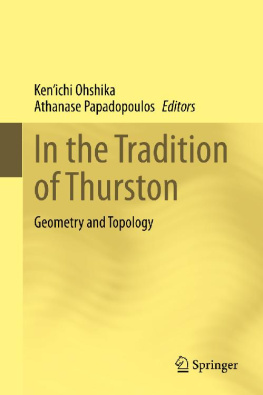Mathematical Thought from Ancient to Modern Times
Mathematical Thought from Ancient to Modern Times
Volume 3
MORRIS KLINE

Oxford University Press
Oxford New York Toronto
Delhi Bombay Calcutta Madras Karachi
Petaling Jaya Singapore Hong Kong Tokyo
Nairobi Dar es Salaam Cape Town
Melbourne Auckland
and associated companies in
Berlin Ibadan
Copyright 1972 by Morris Kline
First published in 1972, in one volume, by Oxford University Press, Inc.,
200 Madison Avenue, New York, New York 10016
First issued as an Oxford University Press paperback, 1990
Oxford is a registered trademark of Oxford University Press
All rights reserved. No part of this publication may be reproduced,
stored in a retrieval system, or transmitted, in any form or by any means,
electronic, mechanical, photocopying, recording, or otherwise,
without the prior permission of Oxford University Press, Inc.
Library of Congress Cataloging-in-Publication Data
Kline, Morris, 1908
Mathematical thought from ancient to modern times / Morris Kline.
p. cm. Includes bibliographical references.
ISBN 0-19-506137-3 (PBK) (v. 3)
1. MathematicsHistory. I. Title.
QA21.K516 1990 5109dc20 89-25520
10 9 8
Printed in the United States of America
Preface to the Three-Volume Paperback Edition of Mathematical Thought
The reception accorded the original edition of this book is most gratifying. I am flattered, if not a penny richer for it, by a pirated Chinese translation. Even more satisfying is a forthcoming authorized Spanish translation.
This work is part of my long-time efforts to humanize the subject of mathematics. At the very beginning of my career I banded with a few colleagues to produce a freshman text that departed from the traditional dry-as-dust mathematics textbook. Later, I wrote a calculus text with the same end in view. While I was directing a research group in electromagnetic theory and doing research myself, I still made time to write Mathematics In Western Culture, which is partly history and partly an exploration of the influence of mathematics upon philosophy, religion, literature, art, music, economic theory, and political thought. More recently I have written with the general reader in mind a book on the philosophical foundations of mathematics and a book on the underlying mathematical structure of a good deal of science, most especially cosmogony and physics.
I hope that students, teachers, as well as the general reader will profit from this more affordable and accessible three-volume paperback edition of Mathematical Thought. I wish to acknowledge the helpful suggestions made by Harold Edwards, Donald Gillis, and Robert Schlapp among others. My very special thanks go to Fred Pohle for his time, interest, and generosity. Having over the years taught a course based on this book, he saw a need for a multi-volume paperback version and provided the impetus for this edition. Beyond this he gave unstintingly of his time and knowledge in helping me correct errors. I am truly in his debt, as I am to my wife Helen, who undertook much of the work involved in preparing this edition.
Preface
If we wish to foresee the future of mathematics our proper course is to study the history and present condition of the science.
HENRI POINCAR
This book treats the major mathematical creations and developments from ancient times through the first few decades of the twentieth century. It aims to present the central ideas, with particular emphasis on those currents of activity that have loomed largest in the main periods of the life of mathematics and have been influential in promoting and shaping subsequent mathematical activity. The very concept of mathematics, the changes in that concept in different periods, and the mathematicians own understanding of what they were achieving have also been vital concerns.
This work must be regarded as a survey of the history. When one considers that Eulers works fill some seventy volumes, Cauchys twenty-six volumes, and Gausss twelve volumes, one can readily appreciate that a one-volume work cannot present a full account. Some chapters of this work present only samples of what has been created in the areas involved, though I trust that these samples are the most representative ones. Moreover, in citing theorems or results, I have often omitted minor conditions required for strict correctness in order to keep the main ideas in focus. Restricted as this work may be, I believe that some perspective on the entire history has been presented.
The books organization emphasizes the leading mathematical themes rather than the men. Every branch of mathematics bears the stamp of its founders, and great men have played decisive roles in determining the course of mathematics. But it is their ideas that have been featured; biography is entirely subordinate. In this respect, I have followed the advice of Pascal: When we cite authors we cite their demonstrations, not their names.
To achieve coherence, particularly in the period after 1700, I have treated each development at that stage where it became mature, prominent, and influential in the mathematical realm. Thus non-Euclidean geometry is presented in the nineteenth century even though the history of the efforts to replace or prove the Euclidean parallel axiom date from Euclids time onward. Of course, many topics recur at various periods.
To keep the material within bounds I have ignored several civilizations such as the Chinese, Japanese, and Mayan because their work had no material impact on the main line of mathematical thought. Also some developments in mathematics, such as the theory of probability and the calculus of finite differences, which are important today, did not play major roles during the period covered and have accordingly received very little attention. The vast expansion of the last few decades has obliged me to include only those creations of the twentieth century that became significant in that period. To continue into the twentieth century the extensions of such subjects as ordinary differential equations or the calculus of variations would call for highly specialized material of interest only to research men in those fields and would have added inordinately to the size of the work. Beyond these considerations, the importance of many of the more recent developments cannot be evaluated objectively at this time. The history of mathematics teaches us that many subjects which aroused tremendous enthusiasm and engaged the attention of the best mathematicians ultimately faded into oblivion. One has but to recall Cayleys dictum that projective geometry is all geometry, and Sylvesters assertion that the theory of algebraic invariants summed up all that is valuable in mathematics. Indeed one of the interesting questions that the history answers is what survives in mathematics. History makes its own and sounder evaluations.
Readers of even a basic account of the dozens of major developments cannot be expected to know the substance of all these developments. Hence except for some very elementary areas the contents of the subjects whose history is being treated are also described, thus fusing exposition with history. These explanations of the various creations may not clarify them completely but should give some idea of their nature. Consequently this book may serve to some extent as a historical introduction to mathematics. This approach is certainly one of the best ways to acquire understanding and appreciation.
Next page














